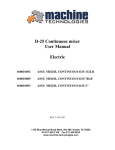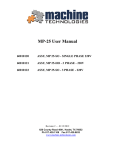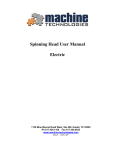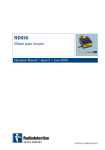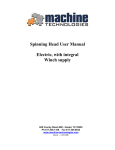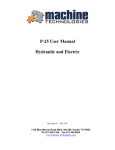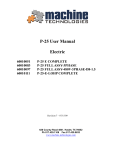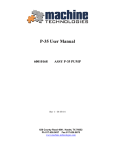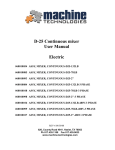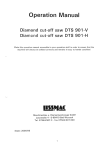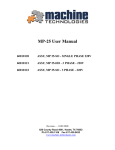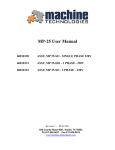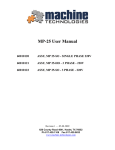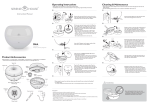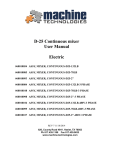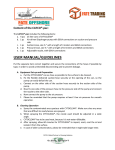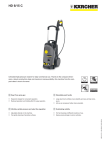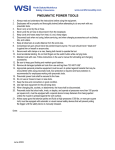Download Spray gun - Machine Technologies
Transcript
Spray gun (wet) assembly and operation. ASSY, KIT SPRAY NOZZLE-8"WAND #60010076 REV- 4 APRIL 2015 620 County Road 4841. Haslet, TX 76052 Ph 817.636.5637 Fax 817.636.5675 www.machine-technologies.com Contents Page Section 1 - General Safety information.........................................................................2 Danger ........................................................................................................................2 Section 2 – Spray gun description / Views....................................................................3 Spray gun function.....................................................................................................3 Spray gun illustrations...............................................................................................4 Spray gun assembly. ...............................................................................................4 Spray gun cap, base, and fittings............................................................................5 Section 3 – Operation of the spray gun.........................................................................6 Preliminary connections ............................................................................................6 Running the Spray gun ..............................................................................................6 Material spray adjustments .......................................................................................8 Section 4 - Spray Gun clean up, gun care, and simple trouble shooting .....................9 Cleaning......................................................................................................................9 Gun care .....................................................................................................................9 Trouble shooting ......................................................................................................10 Blockage removal ..................................................................................................11 LIMITED WARRANTY POLICY............................................................................12 Page 1 Section 1 - General Safety information Danger Follow these instructions very carefully, in order to avoid injury to yourself or others. NEVER look directly into the nozzle. Always keep the nozzle pointed away from people and animals. Never disassemble the spray gun while material is flowing, or when air is flowing. Never use sharp objects to clean the spray gun. Page 2 Section 2 – Spray gun description / Views Spray gun function The spray gun is pneumatically and hydraulically powered. Pneumatically by the air pressure used to help “atomize” the material, and hydraulically by the material pushed from the pump unit through the chosen nozzle. The spray gun is coupled to the material supply via the cam-lock fitting. Material is pumped from the pump unit through a hose into the spray gun. As the material passes through the interchangeable nozzle, inside the spray gun, air is forced into the stream of material, causing the material to “atomize” or breakup into a “spray”. The spray is directed towards the wall or structure to be coated, and moved around to evenly coat the area. Do not apply too much material to one spot at anyone time, as the material will tend to “run” or “slump” and may fall from the area being coated. Page 3 Spray gun illustrations Spray gun assembly. Page 4 Spray gun cap, base, and fittings Note. Some items might not be available individually due to assembly practices Page 5 Section 3 – Operation of the spray gun. Preliminary connections Ensure that your air compressor is capable of outputting approximately 10 to 13 CFM, free air delivery. Pressure is not an important issue, compared to physical flow through the nozzle. The typical pressure that the gun will run at is between 25 and 50 PSI, but at a high flow rate. Ensure that your air line has a suitable fitting to connect to the air fitting on the gun (a GEKA style fitting is supplied with the gun, with a hose tail suitable for ½” bore air hose) Ensure that you have a 25mm male cam-lock fitting at the end of the pump hose, allowing a direct connection to the fitting on the spray gun. Ensure that your pump unit has hoses primed, and ready to discharge, a smooth, wet, lump free grout mix. Any lumps in the mix will increase the likelihood, of a blockage in the nozzle, the smaller the nozzle, the smaller then lump. Ensure that you have the required nozzle fitted to the spray gun. Running the Spray gun With the air pressure and air flow turned off (valve shown open), connect the spray gun to your air supply, via the GEKA fittings supplied. Page 6 With the pump unit turned off, and no material flow, clean the end of your grout hose, and connect to the spray gun. Ensure that both cam-locks are engaged. Turn on the air supply. Open the air control valve on the spray gun, so that air can be heard coming from the gun. Then turn on the material flow, and then adjust both the material flow and the air flow until the desired spray results are seen. Page 7 Material spray adjustments If too much “splattering” is seen, then either the air flow is insufficient, or the material flow is too high. To remedy this either readjust the air and /or material flow rates, of reduce the nozzle size. If the material flow is insufficient, or poor material deposition rates are seen, then following the air and material flow adjustments, a nozzle size increase can be tried. Remove the spray gun cap, remove the nozzle, and replace with one of a larger size. Replace the spray gun cap, and hand tighten, making sure that the nozzle is correctly located in the base. Nozzles are available with four sizes, of orifice, namely 6mm, 8mm, 10mm and 12mm. Page 8 Section 4 - Spray Gun clean up, gun care, and simple trouble shooting Cleaning After use, or sometimes during use, the gun will start to suffer from material build up, either through being handled by dirty hands, being placed in or on fresh material, or from back spray. Any material must be removed before it hardens, using a warm water and soap solution. Ensure that the material pump is turned off, and the air pump be turned off and discharged before any disassembly is carried out. Avoid the use of sharp objects to remove any hardened material, or damage could result to the alloy gun body, the polymer end cap or the nozzle. Avoid the use of caustic cleaning solutions, or damage to the alloy gun base will result. Gun care It is suggested that a de-moisturizing agent such as WD-40® be applied to the cleaned nozzles and base before packing, to help keep the parts from corroding and rusting. Individually wrap each nozzle, in a wipe cloth dampened with WD-40® to prevent rusting and damage. Once cleaned, replace the spray cap onto the spray gun base to prevent loss. Ensure that the rubber seal fitted to each of the air connections is in good condition, and NOT oiled. Ensure that the sealing washer fitted inside the cam-lock fitting is in good condition and NOT oiled, or contaminated with hardened material. Page 9 Trouble shooting The spray gun, is a simple, mechanically operated component, comprising of few parts. In the event of a malfunction of the spray gun, it should be obvious as to the reason for malfunction, and to the solution, however the following can occur. If the material being supplied to the spray gun has not been mixed well, or poor quality materials have been added to the mix, such as larger particles of stone, rock or similar, then the spray gun will “block”, allowing only air to spray out. A blockage can manifest itself in a couple of ways, such as a reduction in the material flow rate, being a partial blockage, causing a poor spray coverage, or the material flow suddenly stopping, being a full blockage, causing not coverage. A partial blockage will likely keep reoccurring reflecting the poor quality of the mix, but will most likely not stop the job, except for a possible poor finish to the coated surface, the effects of which could be reduced by setting up the gun to use a larger nozzle, if possible. A full blockage will cause the material feed pipe to suddenly swell in diameter, and for it to straighten out as the internal pressure builds. In the event of a blockage, STOP the pump immediately, shut off the air at the air valve on the gun, and perform the following as soon as possible. Page 10 Blockage removal To remove the blockage, all pressure inside the material hose must be relieved, this can be done by leaving for a short period of time until the pressure naturally dissipates, or by turning the pump to “reverse” for a couple of seconds. NOTE. Do not run the pump in reverse for more than a second or two or the “blockage” may get sucked back into the material hose, requiring further removal, and/or the pump may become damaged. • Once the pressure in the material hose is removed, unclip the cam-locks on the material hose connection, and remove the hose from the back of the gun. • Apply a water hose the front of the spray gun through the nozzle to “flush out the blockage. Doing this over a clean hard standing will allow the easier detection of the blockage, allowing the reason for blockage to be determined easier. • Keep flushing the spray gun until a clear sight path can be established through the gun. Pay particular attention to the material fitting when flushing. • Turn the pump ON, for approx 10 seconds, with the material hose placed in a waste collection vessel, allowing the contaminated material to purge from the pipe. • Turn OFF the pump, clean the hose end, and reassemble the gun to the material hose, making sure the cam-locks are secure. • Open the air valve, and re-start the pump, to continue spraying. It is not recommended that the compressed air in the pipe be used to “reverse” purge the material from a disconnected cam-lock fitting. Page 11 LIMITED WARRANTY POLICY Machine Technologies warrants each of its new machines to be free of defects in material and workmanship under normal use and services for a period of one (1) year from the date of delivery. The warranty is issued ONLY to the INITIAL USER. The warranty period begins when the product is delivered to the initial user or when first put into service, whichever occurs first. Said warranty is void if the machine is subject to misuse, neglect, accident or abuse. Machine Technologies’ obligation under this warranty is limited to correcting without charge, at its warehouse, any parts or parts thereof which shall be returned to its warehouse, transportation/shipping prepaid and upon Machine Technologies’ examination proves to have been originally defective. Correction of such defects by repair or replacement shall constitute fulfillment of all obligations to the initial user. This warranty does not include labor or transportation charges unless specifically identified and authorized in writing by Machine Technologies. Nor does the warranty apply to any unit upon which repairs or unauthorized alterations have been made. The warranty does not apply to normal maintenance service or to normal replacement of certain machine parts which are subject to normal wear (including but not limited to pins, bushings, rotors, stators, hoses, spray caps, spray nozzles, mixing shafts, shaft couplings and connectors, dosing shafts, pump shafts, filter elements and tires). THIS IS A LIMITED WARRANTY AND IS IN LIEU OF ANY OTHER WARRANTIES, EXPRESSED OR IMPLIED, INCLUDING ANY WARRANTY OF MERCHANTABILITY OF FITNESS FOR A PARTICULAR PURPOSE. In no event shall Machine Technologies be made liable for incidental, general or consequential damage, loss or any expense directly or indirectly related and resulting from use or lack of use caused by delay in delivery, parts failure, or any other causes associated with the product use. No person, firm or corporation is authorized to assume for Machine Technologies any other liability in connection with the sale of Machine Technologies products. Page 12














